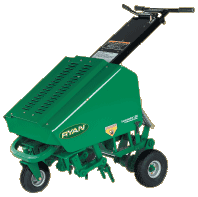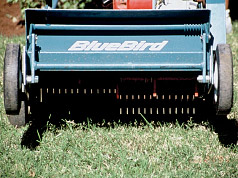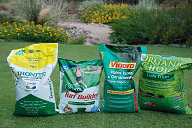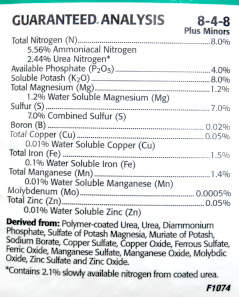Summer is the time to get your lawn back into shape! Warm season grasses love the heat and the humidity. This is your opportunity to get your sod grass lawn in the best possible shape. There are a few essential procedures that can help any yard – fertilization, dethatching, and an irrigation check-up. Click the links below to jump down the page.
- Tips for Established Lawns
- Dethatch Method 1 - Aerification
- Dethatch Method 2 - Power Rake
- Irrigation Check-Up
- Watering Schedules
- Fertility
- Special Requirements: Performance St. Augustine & Celebration Bermudagrass
- Confused by fertilizer labels?
Tips for Established Lawns
One of the main causes of lawns looking "old and tired", or thinning out, is thatch build-up. Thatch accumulates during the winter if you over-seed your lawn. If you don't over-seed, thatch accumulates during the summer, but is made worse during the winter when the summer lawn goes dormant and the old leaves begin to die. After a number of years of thatch accumulation, the thatch begins to form a layer that repels water and does not allow the soil to "breath". Lawns with excessive thatch will begin to have large areas that look thin, wispy, and eventually brown. These areas will also repel water, or allow water to puddle for an extended period of time. Stick a screwdriver in the ground and see how far it goes in the ground before it hits dirt. If your thatch is more than an inch in depth you are beginning to have a serious thatch problem. When these symptoms begin to appear it is time to dethatch!
Dethatch Method 1 — Aerification

Old lawns with extreme thatch, or lawns with heavy traffic are good candidates for aerification. Aerification is normally performed with a machine that pulls small "cores" out of the lawn, about ½" in diameter. These holes will allow oxygen into the root zone, improve water penetration, and will relieve the lawn of compaction. This is a service that can be by a contractor, or you can rent an aerator from a local equipment rental company and do it yourself. Please note that aerification is not a replacement for dethatching.
Dethatch Method 2 — Power raking
 This is the easiest method to remove excessive thatch from a sod grass lawn. There may be a lot of material to haul-off, but with the right machine it is not a difficult job. Power rakes, dethatching machines, or verticutters as they are sometimes called, have a series of "knives" that dig lightly into the lawn and pull-up old leaves and debris. Run the verticutter over the lawn, then rake and remove the debris. When you are done dethatching, fertilize with a full rate of fertilizer (1 pound of actual nitrogen per 1,000sf) to aid the turf with recovering quickly from the process. Verticutting machines can be rented at a local equipment store.
This is the easiest method to remove excessive thatch from a sod grass lawn. There may be a lot of material to haul-off, but with the right machine it is not a difficult job. Power rakes, dethatching machines, or verticutters as they are sometimes called, have a series of "knives" that dig lightly into the lawn and pull-up old leaves and debris. Run the verticutter over the lawn, then rake and remove the debris. When you are done dethatching, fertilize with a full rate of fertilizer (1 pound of actual nitrogen per 1,000sf) to aid the turf with recovering quickly from the process. Verticutting machines can be rented at a local equipment store.
Irrigation Check-up
99% of the problems found on sod grass lawns in California are associated with water, too much or too little. Because most irrigation clocks are set to run at night or early in the morning, most people never actually see their sprinklers in action. Many times heads can become plugged with debris, parts wear-out, nozzles get turned the wrong direction, and the list goes on and on…
Turn your system on and watch it run. Any areas that usually turn bluish gray demand your attention first. Make sure that you have 3 heads hitting each area of the yard (they call this triangular spacing). Any area that only has two heads covering it will most likely start showing signs of stress first. Adjust your sprinklers to get the proper coverage. Also make sure that the sprinklers get "head-to-head" coverage.

Watering Schedules
Established sod lawns will require water 2-3 times per weeks, applying the equivalent of three quarters of an inch to half-inch of water per watering cycle. New lawns (installed within the last 4-8 weeks) may still require nightly watering. For more detailed information on watering you may also visit the University of California Healthy Lawns website.
Fertility
A healthy sod lawn begins with healthy soil. Your lawn requires a good source of nutrients to maintain its color and vigorous growth. Be careful not to over-fertilize, as this can cause excess growth, excess thatch build-up, and excess work for YOU! Too little fertilizer can leave your lawn thin, yellow, and slow to recover from wear. To keep it looking its best, your lawn requires a balanced diet, with the right amount of food on a consistent schedule—just like people do!
 Lawns should be fertilized monthly with a complete fertilizer using an analysis similar to a 29-2-4 with iron, or 28-0-4 with iron. Feed the lawn monthly until the sod is thick and dense.
Lawns should be fertilized monthly with a complete fertilizer using an analysis similar to a 29-2-4 with iron, or 28-0-4 with iron. Feed the lawn monthly until the sod is thick and dense.
A lawn that is thick, dense, and dark green may only require fertilizing every 6-8 weeks, therefore a slow-release fertilizer is recommended. Slow release fertilizers slowly spoon feed the nutrients over time, allowing for a small constant feeding to the root system. This will allow for continued dark green color with slower growth. Slower growth means less thatch and less mowing!
Special requirements: Performance St. Augustine
Performance St. Augustine is a unique variety of sod grass, adaptable to partial shade, but also grows in full sun. One of the benefits of Performance is that it does not require a lot of nitrogen. Performance should be fed with a fertilizer high in potassium and magnesium. Many palm tree fertilizers are suited well for Performance. They have a high amount of potassium and a micronutrient package that will green-up the lawn, but not cause excessive growth. Performance can be susceptible to some diseases if it is allowed to build-up excessive thatch. Feed Performance at a half rate of what is recommended for most grass varieties.
Once the lawn has reached full density, fertilize at a half rate monthly with a soluble fertilizer like ammonium sulfate, or a full rate of a slow release fertilizer (29-2-4) every 6-8 weeks. This will keep the lawn dark green, but will not force it to grow excessively. Once your lawn has reached full density, you can reduce watering to only 1-2 times per week (water deeply) giving you a dark green, drought resistant yard, that will require mowing only once every 7-10 days.
Confused by fertilizer labels?
Learn about the role of fertilizer in this downloadable PDF.

In This Section
Helpful Information
For questions or to order by phone call:
800-553-8328
Get FREE delivery with orders of 960 sq/ft or more.
Use our Lawn Selector tool to help you select your sod. A few simple questions will tell you which varieties are best suited for your location and your lifestyle.
We'll remind you when it's time to reseed & change your irrigation schedule. You can remove yourself from our list at any time.




